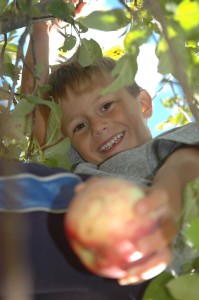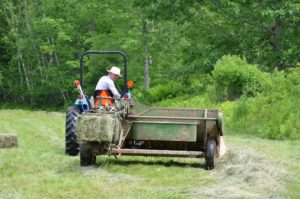Not sure how to explain it, but this has been a great year for apples in our part of Maine!
 Also for plums and blueberries, maybe every other kind of fruit, but most certainly for apples. The Backler clan joined Wendy and me in taking full advantage of this new alignment of the apple stars. First we rediscovered a small orchard just around the corner (Mount Nebo Orchard). Then we harvested apples from our own trees which this year bore plentiful and nearly blemish-free fruit. (We planted these trees twenty years ago and have never had much out of them before now.)
Also for plums and blueberries, maybe every other kind of fruit, but most certainly for apples. The Backler clan joined Wendy and me in taking full advantage of this new alignment of the apple stars. First we rediscovered a small orchard just around the corner (Mount Nebo Orchard). Then we harvested apples from our own trees which this year bore plentiful and nearly blemish-free fruit. (We planted these trees twenty years ago and have never had much out of them before now.)
The Mount Nebo Orchard was a great surprise. The orchard had been somewhat in decline in recent seasons following the death of its original owner, but a couple of years ago Jeff and Sandi Wiles took on management. They brought in a team to trim and clean, generally restoring trees and grounds to their former robust condition. This investment, along with whatever natural forces were at work, resulted in a truly spectacular crop this year. Beyond standard Maine varieties – McIntosh, Cortland, and Delicious – we jumped at the chance to try a number of lesser known strains – Pumpkin Sweet, Macoun, Winter Banana, and Turley Winesap (and that’s just to name a few!). Continue reading Apples, apples everywhere!

 For those of you not from “around here,” I’ll explain that boiling the sap of a maple tree, usually a rock or sugar maple, eventually yields maple syrup, the thick, sweet substance that we like to eat on pancakes – or on any number of other things for that matter. (About forty gallons of sap yields one gallon of syrup!) Maple sap flows best in the spring of the year when the temperature falls below freezing at night, then warms up during the day. All kinds of things can affect this flow. The amount of rain we got the previous fall, spring too cold or too warm. A slight breeze can shut down a good run on the nicest day. Making maple syrup is the kind of practice that generates a heightened awareness of the weather; making hay in summer is another such practice. (More on making hay when the time comes.)
For those of you not from “around here,” I’ll explain that boiling the sap of a maple tree, usually a rock or sugar maple, eventually yields maple syrup, the thick, sweet substance that we like to eat on pancakes – or on any number of other things for that matter. (About forty gallons of sap yields one gallon of syrup!) Maple sap flows best in the spring of the year when the temperature falls below freezing at night, then warms up during the day. All kinds of things can affect this flow. The amount of rain we got the previous fall, spring too cold or too warm. A slight breeze can shut down a good run on the nicest day. Making maple syrup is the kind of practice that generates a heightened awareness of the weather; making hay in summer is another such practice. (More on making hay when the time comes.)  On our recent trip to South Africa (see earlier posts), we had only a few encounters with the music of the place, but they offer a chance to ruminate on the subject (music and place) based on at least some specific experience. I didn’t know much about South African music to begin with – Hugh Masekela, Miriam Makeba. Oh, and Ladysmith Black Mombazo, and Dave Matthews. These were South Africans who had brought their music(s) to our shores. But what would I find in the place itself?
On our recent trip to South Africa (see earlier posts), we had only a few encounters with the music of the place, but they offer a chance to ruminate on the subject (music and place) based on at least some specific experience. I didn’t know much about South African music to begin with – Hugh Masekela, Miriam Makeba. Oh, and Ladysmith Black Mombazo, and Dave Matthews. These were South Africans who had brought their music(s) to our shores. But what would I find in the place itself?